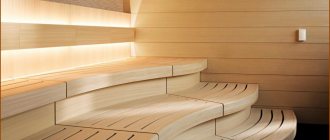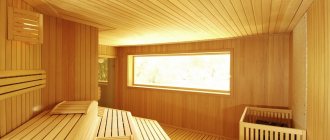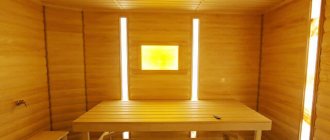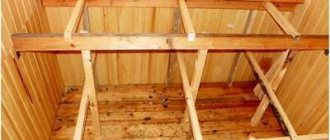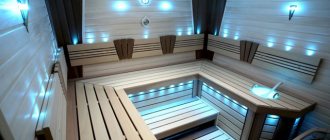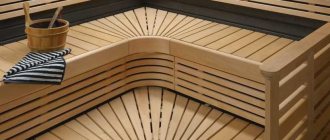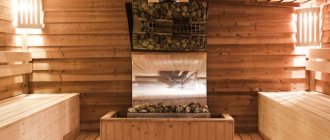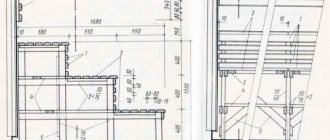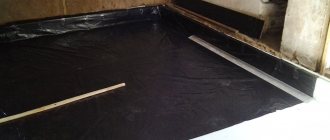The height of the shelves in a bathhouse is an important parameter on which comfort, ease of stay and the benefits received depend. However, there is no special standard for the size of shelves for a bathhouse, fixed in official recommendations. The optimal options are calculated in advance, regardless of who is doing the construction - professional, experienced craftsmen, or the owner who decided to build the structure with his own hands. The determining factors for choosing the height of the shelves can be the size of the bathhouse, the type of stove used, the number of people for which the design is designed and the type of shelves used.
Bathhouse in the village
Height - basic calculations
Every man, as a rule, wants to take part in the improvement of his site.
The mere thought that this decision comes from him, that he has the freedom to decide, lifts the spirit and pleases the heart. And what an unforgettable feeling of pride will arise upon completion of construction. “This is my job,” he will say to every guest who comes, and they, in turn, will have the opportunity to envy.
The instructions described below are intended for those who want to understand how to properly build a ceiling in a bathhouse with their own hands.
Calculating the height of the ceiling in the steam room
Options for accommodating people in the steam room
Every lover of a “hot” bath thinks about how to spend less resources on heating, but at the same time not lose money on its heating. Of course, the height of the ceiling will help in this matter, since the lower it is, the higher the temperature. Common sense is that you will still want to stand up to your full height without hitting your head!
So, let's start practicing:
According to the standard, the log frame of a bathhouse is 2.8-3 meters in height, but the height of the ceilings in the bathhouse in this case will be 2.4 meters from the floor.
These calculations will be reflected in a simple and quick way to warm up a steam room, and the consumption of material for heating the room will be kept to a minimum.
- If you are a fan of high ceilings, remember that this requires further increasing the size of the box itself.
- Hot air is rapidly directed upward, so bathhouse ceilings that are too low will make it difficult to breathe in the room.
Note: the height of the bath from floor to ceiling depends on the optimal standardized dimensions, as well as on the height of the benches.
Hot air and steam are concentrated, as a rule, under the ceiling, so shelves in the steam room, at least two or three rows, should suit everyone (photo).
As you can see, the temperature in the steam room greatly depends on the height, so it is necessary to provide shelves for both “experienced” and beginners.
At the top there may be well-adapted people, so to speak “old men”, who do not faint from a sudden temperature change. The lower part is less heated, so for those who want to get used to “hot” procedures, it is better to start with it.
There are three options for placing shelves in the steam room:
Stepped shelves are the standard and most common layout option
- (photo) is a convenient solution for a small bathhouse. The bench is located along the wall, where at the junction of the corner it goes along the other side, visually forming the letter “g”. In this case, the height will not be large. All bathhouse visitors will sit on the same level, which does not require additional calculations. If a person is in a lying position on a shelf and bends his legs, then in this case the distance from him to the ceiling should be at least 160 cm. At this distance, the knees of the person lying will not touch the top.
L-shaped shelves are suitable for a small steam room
- (photo below) is an excellent solution in terms of saving space, so two shelves are located on the wall. Yes, like in a carriage compartment, so when calculating, do not forget to take into account that the room is small, and a person needs additional space in order to climb onto the upper tier. The minimum length of the bench in this case is 150 - 180 cm, and the height from the tier is at least 50 cm.
This layout is a legacy of long-distance trains.
You can often find combined layout options.
Calculation of the height of the dressing room, washing room and locker room
The pleasure of staying in a steam room depends on the temperature of the room, and in other rooms of the bath, on the comfort of being in them. The washing room, locker room and dressing room should be equipped with a high vault, since the “freshness” of the air will be increased by the given height parameters.
Do not make the washing room too high.
A height of 3.5 meters is quite appropriate for rooms. It is better to take care of the low floor, which serves as a barrier, preventing cold air from other rooms from entering the steam room.
The traditional method of determining height has not lost its relevance today.
What types of wood are they made from?
It is believed that bath shelves are best constructed from hardwood, since this material not only has very low thermal conductivity, but also boasts fairly high wear-resistant qualities. In addition, in terms of the composition of healing fumes, shelves made of deciduous wood have practically no equal.
Abashi
It is not without reason that African oak wood is considered an almost ideal solution for making bath benches and sun loungers. Due to its high density, abashi wood is very resistant to both high humidity and various types of mechanical stress. Over time, this lumber practically does not deform and does not shrink. As a rule, the porous structure of African oak has a very beautiful fine texture with a noble cream or slightly yellowish tint.
Alder and black alder
The main advantage of alder is its extremely low thermal conductivity, which means that steaming on alder shelves will be very comfortable and pleasant. In addition, alder does not crack under the influence of high temperature and high humidity.
Also, over time, it practically does not change its light, noble shade. Therefore, if you want to build a shelf of a darker color, then use black alder wood for its manufacture, which in its properties and quality characteristics is practically not inferior to traditional gray. The disadvantages of alder include very mediocre flexibility and a fairly high tendency to rot.
Maple
Despite its fairly high density, maple wood is characterized by very good flexibility and high wear resistance. Typically, maple material is very easy to process, so almost any carved parts can be made from it.
It should also be noted that many varieties of maple have a very beautiful texture with clearly visible core rays. The wood of many maple varieties has a standard yellowish hue, but some species boast a more unusual reddish-brown or whitish-cream color palette.
Linden
In terms of price-quality ratio, linden wood is considered one of the best. However, many people like this material primarily because when heated, linden wood begins to release a very pleasant woody aroma into the air, which has pronounced healing properties.
It is believed that the essential oils secreted by linden contain special substances that in many cases help prevent colds and various nervous diseases. As a rule, linden wood has a slightly yellowish tint, but under constant exposure to moisture it can darken over time.
Aspen
Aspen is also a budget option. Despite its low cost, this material usually withstands use in a Russian bathhouse very well. In addition, it lends itself perfectly to processing with various hand tools and retains its very attractive appearance for a long time.
However, when choosing this material, it should be taken into account that aspen has a fairly high tendency to rot from the inside. Therefore, before purchasing this lumber, it is recommended to cut at least one board from the supply in order to check the wood for initial signs of rotting.
Poplar
Soft poplar wood is characterized by a texture that is not too dense. Most often it has a light brown or yellowish-brown tint without pronounced medullary rays. Despite its inconspicuous appearance, the aesthetic properties of wood can be significantly improved through the use of special impregnating compounds. As for strength, poplar wood has rather weak indicators.
Steam room interior
Although the main quality of a steam room is its effectiveness and convenience, appearance also matters. That's why:
All elements are finished taking into account not only safety and comfort, but also aesthetics. High-quality surface coatings, including oil-wax, can reveal the texture of wood and emphasize the laconicism of thoughtful forms; the use of one or more harmonizing types of wood for decoration increases the attractiveness of the interior
When choosing materials, it is important to consider the correspondence of the color scheme of furniture, walls (ceiling, floor) and stove; Correctly selected lighting (hidden or semi-hidden lamps of a suitable style) and a rational choice of accessories will help make the procedures more enjoyable.
Bath shelf size: correct calculation
Before you make shelves in a bathhouse with your own hands, you should carry out many calculations. It is necessary to decide on the number of tiers. Recently, more and more owners of steam rooms are making two- and three-tier shelves. Single-tier shelves are traditional for Russian baths. Multi-level benches are more typical for saunas, where people sit rather than lie down. Next, you need to decide on the dimensions of the structure.
- Height. This parameter is selected in such a way that the steamer can easily work with his hands and does not have to bend too much. Experts recommend placing shelves at the level of the bend of the thumb of the hand lowered down. The height of the product ranges from 70 to 90 cm. Many people like to take bath procedures while sitting, so it should be comfortable to lie and sit in the steam room. A distance of 110 to 150 cm should be maintained between the shelf and the ceiling.
- Lenght and width. A bathhouse is a place where a person wants to relax as much as possible, so the length should allow him to lie down at his full height. On average, the length of a standard shelf is 220 cm and the width is 90-100 cm. Traditionally, the product is placed along the walls, and their number largely depends on the size of the steam room. If you are the owner of a large bathhouse, you can double the width of the shelf so that 2 people can sit on it at once. Before you add more shelves to your bathhouse, make sure that it will not take up too much space and interfere with the steamer. In small spaces, the “compartment” option is often found. In this case, the bench with the shelf is attached to one of the walls; if necessary, the shelf is folded back and secured to the bench. It can be easily returned to its original position. Often there is an option when a stationary shelf is combined with a mobile bench.
The sizes of the shelves are selected depending on the position and number of people steaming
Tips and Tricks
To preserve the original appearance of the shelves in the bathhouse, you will need to follow a number of rules:
- Each time after using the steam room, ventilate and dry the bathhouse.
- Regular cleaning will prevent the appearance of harmful microorganisms and mold growth. It is necessary to thoroughly wash off dirt and condensation from the shelves.
- To make the shelves dry faster, after bath procedures they are thoroughly wiped with a dry towel.
- It is not advisable to use household chemicals when cleaning a steam room in a bathhouse, since wood actively absorbs various substances and odors. The entire range of detergents will replace laundry soap. Cleaning is done with a brush with soft bristles. In extreme cases, use fine-grain sandpaper.
When ventilating the bathhouse, you need to open the doors and windows, and cover the existing water barrels.
The choice of the type of shelves in the bathhouse, the material, competent assembly and installation will make the steam room a wonderful place to relax. Its interior will bring joy to all vacationers, and with proper and regular care, the steam room will not require additional investments in the future.
How to make shelves with your own hands - step-by-step instructions
After developing the drawing, you can proceed to preparatory work.
Materials, tools
Materials you will need:
- Bars or thick boards for the frame. Standard section - 50*50 mm, 50*80 mm, maximum permissible - 100*100 mm.
- Edged boards, lining for flooring. Thickness - up to 25 mm. The width is taken no more than 4 times the thickness. The quantity depends on the fastener pitch. The recommended fixation step is from 1 to 2 cm.
- Fastening elements - galvanized self-tapping screws, steel corners. To make folding shelves, stainless steel hinges are also used.
The wood used must be free of defects. The surface is checked for roughness.
Tools you will need:
- screwdriver;
- hacksaw for metal;
- construction mallet;
- hammer;
- tape measure, pencil;
- chisel;
- jigsaw;
- sandpaper.
Next, you should start making future benches.
Build process
It is necessary to pre-cut the supports of the required length and transverse lintels (the length is determined by the depth of the shelf).
The assembly steps are as follows:
- The frame is made from the top tier, close to the wall.
- Support bars are fixed to the walls along the edges of the future shelf and in the gaps. This creates a binding belt.
- Opposite these supports, a second row of racks is placed in parallel and connected to the first row by transverse jumpers.
- The supports are fastened together using the same horizontal jumpers, forming an external frame.
- The frame of the lower tier is attached to the outer trim. The procedure is repeated step by step in the same sequence.
To minimize the effect of moisture on the supports, before attaching the flooring, rubber or plastic gaskets are fixed to them.
To lay the flooring:
- Take a 20*120 mm edged board. Length - 3.5 m.
- Laying is done perpendicularly, along the frame posts.
- Fixed with pins or wooden nails. Step - 1-2 cm.
- The corners are rounded and carefully polished.
- An alternative is to secure the boards with galvanized screws from the inside of the frame so that they point outward.
- External screwing of screws from top to bottom is allowed, but the caps must be carefully sunk into the board so that when heated, the person sitting on the shelf does not get burned.
Vertical cladding also has its disadvantages. The main thing is that this becomes an obstacle to the wood drying quickly and complicates maintenance and cleaning of shelves.
In Finnish saunas it is customary to make a backrest above the top shelf. You can buy this accessory ready-made or assemble it yourself.
The partition is covered with slats up to 2 cm thick in increments of 40–60 cm, on top of which boards or lining are fixed.
Design
The element is assembled from a frame, base and boarding, which can be stationary, removable or folding. The basis is made up of support posts (vertical), as well as jumper boards - such a frame is attached directly to the wall. But between the shelves and the wall you need space for ventilation - this is about 8-10 cm. The flooring is made of narrow planks.
Ramunas
In theory, the frame is made from racks - vertically located bars. A diffuse film (membrane) and a vapor barrier are attached exactly over them, and then along these racks (vertically) an air gap is attached, forming a lath two to two and a half cm thick. And the lining is already attached to it - let me remind you, the lining is attached HORIZONTALLY with a “folder” at the top . And the shelves are attached precisely to the racks through this entire sandwich - that is, fastening occurs only at certain points of the wall and not just anywhere.
It is important to leave a gap between the wooden planks of the shelf flooring (it is better to make it removable so that it can be washed and dried in fresh air) so that the water drains and does not remain in puddles. A suitable step is usually 1 cm - sometimes a little more.
Kern:
Kern
I left 1.5 cm gaps between the boards (ours are made of abasha) - this makes them easier to wash and sweep away leaves. The sides were not sewn up, I think there should be some ventilation there
What size should a steam room be in a bathhouse: layout
The size of the steam room can be influenced not only by the number of people the owner is counting on, but also by the presence or absence of a brick oven, which itself takes up enough space and allows you to easily increase the cubic capacity - it heats up evenly for several hours.
We highly recommend reading about the ergonomics of the bath space here. There are diagrams and explanations - everything is there.
Here we will go over the principles briefly as they apply to the issues under consideration.
Minimum dimensions
The smallest size of a steam room is in a Finnish bathhouse. And the minimum number of people is one. So, one person needs 40x60 cm to sit (they sit in a sauna) (in other material you will find a width of 70, but we gave this with a margin so that those sitting next to each other would not touch each other).
Therefore, when you ask a question about what is the minimum size of the steam room, at least specify how many people - for two meters of space is no longer enough. And what kind of bathhouse - in a Russian stove, even if it is metal, it should have an internal heater and be lined with stone or brick.
IMPORTANT! The smaller the cubic capacity of the room, the less power is required from the stove. The more miniature she is, by the way.
Do not take a stove with a large power reserve into a small steam room - wood stoves are difficult to regulate, and you probably won’t find tiny gas stoves. The alternative is electric only.
Find sizes for two here.
Standard
We hope that you yourself understand that there are no “standards”. On average, everything revolves around an area of 2x2 meters; it can be larger, but it usually doesn’t go far from these numbers. Because there is no need to take all the guests to the steam room at once; they go in “shifts.”
In addition, we showed you diagrams that demonstrate how to compactly accommodate 5(!) people in a 1.8x1.8 m steam room. This, of course, is a sauna again, and there is no point in cramming 5 people into such a volume, but the fact itself deserves attention - he says that 2x2 will not necessarily accommodate only 2-3 people.
Optimal
After we said goodbye to the idea of any standards above, let's see (as promised at the beginning) what an optimal steam room consists of.
Firstly, let’s distinguish between a Russian and a Finnish bathhouse, everything is different there.
Russian bath - you need a special stove with a closed heater to get light steam, and with a lining so as not to overheat the steam room, you need space next to the stove - 10-15 cm to the wall with a heat insulator that prevents fire, half a meter - where there is no wall, you need shelves for a lying person and space for steaming him, you need space under the ceiling to collect steam and for swinging a broom.
Sauna - you need good supply and exhaust ventilation with a rate of complete air exchange 5 times per hour, a metal stove with high heat output - it doesn’t matter, wood, electric, gas, the main thing is that it is without a lining, an open heater to get a little heavy steam, narrow shelves of three tiers just to sit on them - this is 40 depths per tier, 120 cm for three tiers
To calculate the optimum for a Russian bath, take the most frequent visitors and measure them - you need height (height) and width (measured while lying down using your arms lying freely along the body). Or you can just give the width of the shelf 120 cm, the foot pads 30 cm, so you have one and a half meters just for the shelves.
Then you figure out where the stove is located, what “spot” of space it will take up along with fire safety, and add to the dimensions of the shelves.
Draw a plan so that the door is opposite the window (if you will ventilate in bursts), under the window there are shelves, and opposite is the stove. Here is a plan that emerges specifically for your case. Give 120 for the shelves - you can sit with your legs pulled up, across, you can lie lengthwise.
You can give both 90 and 60. If you nevertheless looked at the article on ergonomics (see the link above), then you know that both values are suitable for both lying and sitting, only in one case (60) do you deviate to the wall and lean your back against it, and in the second (90) you have to pull your legs up onto the shelves in order to sit against the wall.
How to make shelves in a bathhouse with your own hands: choosing a location
After choosing the type of structure, as well as calculating its dimensions, you need to correctly select the place in which it will be located. This decision is influenced by the type of bath. For example, water procedures in a Russian steam room are usually performed while lying down. In turn, the Finnish sauna requires the presence of places that are made as comfortable as possible for a sitting position.
The preliminary drawing must indicate the dimensions of the room, as well as its features. The diagram must include door and window openings, and also indicate the location of the boiler and any other equipment. Based on this drawing, you can determine the most suitable space for installing a shelf in a bathhouse with your own hands. Photos of the finished premises will help you visually evaluate the advantages of one or another option for the location of this structure.
Note! Canopies are not recommended to be installed under window openings. This is due to safety rules, since the glass may not withstand high temperatures and may burst.
As a result, the fragments can cause harm to people relaxing inside the steam room.
Before installing shelves in the bathhouse, you need to create a drawing
Depending on the individual conditions in the bathhouse and the preferences of the owners, the canopy is installed on the base (legs) or fixed directly to the wall. It is worth noting that the shelves should not be adjacent to the walls, as this negatively affects the circulation of air flow. The recommended distance between the logs and the wall is 10 cm. Slats are fixed to the surface, which will serve as the basis for the vertical structural elements.
To make a bathhouse shelf with your own hands, you should purchase material suitable for this purpose in advance, as well as prepare the tools. When fixing individual structural elements with self-tapping screws, it is necessary to screw them into the wood in such a way that you cannot be injured by them in the future.
When positioning the canopy, it is also necessary to take into account the distance to the doorway so that it does not interfere with free entry and exit. This design should be located at a distance from the boiler and not interfere with free movement around the room. Guided by the rules described above, it will not be difficult to correctly choose a place for a bath shelf.
The shelves in the steam room should be positioned so that they do not interfere with free entry and exit
Do-it-yourself bathhouse shelves: methods of attaching boards
The strength of the structure, as well as its durability, depends on the method of fastening the boards. Today, there are three main options for fixing these products, each of which has its own advantages and disadvantages:
- using self-tapping screws that are embedded in the wood;
- self-tapping screws from the outside;
- oak wedges.
The first method is the most common. This option is most often used when building a bathhouse bench with your own hands. In order to sheathe the frame with boards, self-tapping screws are used, which must be driven as deep as possible into the wood. They can also be used to fasten boards from the outside, but this method is not as popular as the first.
And finally, the third method is to use oak wedges. This method is recommended by experts as it is the most environmentally friendly. The technology of this method involves the organization of special holes into which oak wedges are driven.
The easiest and fastest way to attach boards to the frame is to recess the screw heads deeply into the wood
The boards for the back are fixed in the same way as the sheathing for the shelf. The only difference in this case is the wider gap between the individual elements. Photos of shelves for a bathhouse will help you quickly figure out how to attach the casing to the frame. It would be a good idea to watch several videos on this topic, which clearly explain all the nuances of the installation.
The process of making a shelf with a pull-out bench-lounger
This option is suitable for those who have a small steam room. The height of the steam room is 220 cm, width 180 cm, length 210 cm. This compact system of shelves fits on an area of 110x210x220 cm. The rest of the space is for the stove and for the steamer.
This is what a finished shelf with a pull-out bench looks like
Costs For this shelf with a sunbed, 16 linden boards of 210 cm each, bars for the frame, screws, corners, Tikkurila wood impregnation were used - all together costing about 6,000 rubles. Everything is done by hand.
The top shelf is mounted at a height of 113 cm. Its width is 69 cm, length – 210 cm. The width of the pull-out lounger is 49 cm, and it also takes up space from wall to wall. The distance between the shelf and the lounger is 49 cm, making it convenient to use the lounger as a footrest while sitting on the shelf.
Since the upper stationary shelf is located significantly higher than required by the standards, for the convenience of the soaring, a bench of 3 boards, 36 cm wide, was additionally made. The distance between it and the shelf is 70 cm - this is a quite comfortable value.
The steam room shelf consists of two main elements: a supporting structure made of timber and flooring. The support is made of two load-bearing beams: they are installed along the width of the shelf and connected to each other by jumpers with a pitch of 50 cm:
Shelf frame made of two beams with lintels
One of the beams and the outer transverse beams are attached to the corresponding walls along the entire plane, the second beam is attached to the ends. To secure the lintels, grooves of the required size are made in the beams.
In this case, special racks resting on the wall are used to support the second beam. To ensure a tight connection, the ends of the racks are filed at the required angle. The structure is fastened with screws, two fasteners for each rack.
Thin, well-planed boards with rounded edges are placed on the manufactured frame. Slots 1-2 cm wide should be left between the boards to ensure rapid drainage of water and the necessary ventilation during drying.
The frame was covered with boards, leaving gaps for water to drain (there is also a bench in the photo)
It is important to use boards whose width does not exceed four times their thickness - such material dries well and is not susceptible to cracking during use.
In order to save space in the project under consideration, the width of the lounger is 69 cm, but it is recommended to make shelves at least 90 cm wide, which will require the use of 7 boards.
The principle of manufacturing a retractable lounger is the same as that of a shelf - the frame consists of two longitudinal bars with transverse struts. 5 boards were used for the flooring.
Retractable mechanism device
The design of the retractable “walking” mechanism requires special attention. How to make a folding shelf so that the bottom lounger slides under the top one? The bars are mounted to the end walls of the steam room. To them, and to the sides of the lounger on the inside, axles are attached, on which wooden planks are placed - levers. The corners of the slats should be filed (at least in the upper part) so that they do not interfere with the operation of the mechanism.
The thickness of the bars fixed to the wall must correspond to the thickness of the end elements of the lounger. To ensure that the slats sit tightly on the axle and move without play, wooden washers are installed.
“Walking” mechanism for extending the bench from under the shelf
Home pull-out sofas are made on a similar principle.
The mechanism allows you to effortlessly extend the lounger to a strictly defined distance, which in this case is 0.8 of the length of the lever. The lounger rests on its legs in the fully extended or fully retracted position.
This retractable design is most suitable for steam rooms, in which the length of the shelves and the lounger completely occupy the wall.
Protective wood treatment
Before using the steam room, it is necessary to treat the wood from which the shelves are made. Frequent contact with hot, humid air leads to rapid destruction of the material and deterioration of its appearance. Proper prevention will help avoid the appearance of mold and rot.
Attention! Under no circumstances should you use chemicals, including the usual drying oil and varnish, to treat the shelf. Otherwise, as the temperature in the room increases, substances that have an unpleasant, pungent odor and can cause an allergic reaction will be intensively released into the air.
It is recommended to use impregnation specially designed for bath shelves and benches. It is made on the basis of natural oils and allows you to create a protective film on the outer surface of wooden structures without compromising the natural properties of wood. This product is odorless and does not emit harmful fumes when heated.
A cheaper and more accessible option is edible flaxseed oil, which can be purchased at the grocery store. Hot oil is applied to the wood with a brush; it is recommended to rub it in well.
It is advisable to process the shelves by heating the stove well in the steam room - the oil polymerizes under the influence of high temperature. With another processing method, cold oil is rubbed in, and then the surface is heated with a hair dryer.
What material is best to make a bath shelf from?
Many people advise using material made from leaf trees for these purposes. The reason for this choice is quite simple to explain: coniferous boards at high temperatures release resin, which, if heated strongly, can not only stain the body, but also cause a burn.
Experts recommend choosing boards made of material that has low thermal conductivity. Such wood has a heating limit. If the boards do not get very hot, then you can sit and lie on them without experiencing discomfort. Let's consider what types of wood are most often used to make a bathhouse shelf with your own hands.
The work should begin with the choice of wood for the shelf
Aspen. Aspen is a deciduous tree. This material is common, so it is not difficult to find and buy. Many people note the healing properties of such boards. Among the technical characteristics of such material are strength, resistance to rotting and long service life.
Linden. Boards made from this wood are considered the best in terms of price-quality ratio. Another advantage of linden products is that they have low thermal conductivity and a presentable appearance. Shelves made of linden boards are aesthetically pleasing and pleasing to the eye.
Products made from such material are easy to process, so it is recommended to buy them for people who have no previous experience in working with wood. Making a linden shelf in a bathhouse with your own hands is easier than constructing it from another material. When heated, linden boards emit a very light and pleasant woody smell, which has a calming effect. In addition, they are easy to care for. One of the disadvantages of this material is that it darkens over time. However, this does not in any way affect the performance characteristics of the tree.
Maple. Many experts note that this tree species is a good alternative to linden boards. Products made from this material are more durable and therefore practically do not deform over time. Like linden boards, elements made from maple are great for shelf organization.
It is recommended to use hardwood for the manufacture of shelves and benches.
Poplar. This material is distinguished by its whitish tint and is easy to process. For beginners, this is one of the best options, but products made from this wood are not strong enough. Therefore, it is recommended to use poplar for the manufacture of decorative shelf elements.
Note! When choosing a material for a bath shelf, you must remember that the wood must meet the operational requirements. Abashi (African oak)
Bathroom furniture is often made from this material. African oak is also suitable for a shelf in a sauna. This material is highly resistant to moisture and high temperatures. In addition, African oak boards have low thermal conductivity, which contributes to the ease of use of furniture
Abashi (African oak). Bathroom furniture is often made from this material. African oak is also suitable for a shelf in a sauna. This material is highly resistant to moisture and high temperatures. In addition, African oak boards have low thermal conductivity, which contributes to the ease of use of furniture.
The surface of products made from such wood is very smooth, and its structure favors quick drying. Many experts put this material first in the ratings of the most suitable tree species for shelving.
It is important to choose wood that is resistant to high temperatures and moisture, in which case the shelves can last for many years
Alder. Durable and reliable material, which is highly resistant to deformation. The thermal conductivity of alder boards is one of the lowest, so this wood is an excellent solution for bath furniture.
The choice of a particular material depends on several factors. First of all, this is a financial component. In addition, bath furniture must be able to withstand high temperatures and high humidity, as well as be durable and comfortable. Individual preferences play a big role when choosing material for shelves and benches.
Information about the material and number of boards is recorded in a do-it-yourself diagram. How to make shelves in a bathhouse is a question that many people ask. The answer to this can be obtained by studying the types of bath benches, their features and assembly instructions.
Care instructions
Adviсe:
- The bathhouse must have a good ventilation system so that after the procedures the surfaces dry quickly.
- After visiting the steam room, the surfaces should be wiped with a dry cloth.
- Do not use chemicals to clean wooden surfaces. It is better to choose laundry soap.
- You can clean the wood from dirt with a soft brush. If stains remain, you need to use fine sandpaper, but after this treatment the surfaces must be coated with an antiseptic.
- Every month it is necessary to renew the antiseptic layer.
- If fungus or mold appears on the tree, it is necessary to dismantle the affected part and replace it with a new one.
It is impossible to imagine a classic steam room of a Russian bath or Finnish sauna without wide shelves. They are needed for visitors to sit or lie down when visiting the steam room. Before making your own canopy, you need to select the material and size of the structure.
What optimal sizes should they be in a Russian steam room and a Finnish sauna?
If you yourself have decided what type of steam room you have and want to find out what the optimal dimensions of the shelf in a bathhouse of this type are, then we have divided the information for baths and saunas for you.
Height in the steam room of a Russian bath
It was already said above that the optimal height for a single-tier shelf is 75-90 cm. Two conventional tiers are obtained if you add a mobile bench. But much more often the choice is made on a stationary structure consisting of two tiers.
To make the description clearer, we suggest looking at the picture below:
You see rather narrow shelves in the bathhouse, the height of which differs from the one recommended above: the top is 95 cm, the bottom is 40 cm. The person steaming here has two options - either stand behind the bottom shelf and steam the person lying on the top without approaching, or stand with his feet on the bottom shelf, to get closer to the target. Well, it's hard to say whether it will be convenient for everyone. Yes, and 70 cm is, as it were, neither ours nor yours - you will have to sit more reclined, lying down is a little more comfortable than at 60 cm
IMPORTANT! Still, we insist that the height of the shelves in the steam room have an anatomical correspondence to the people who most often steam others. That is, do it up to the knuckles of his hand.
What height should a sauna be?
But here there is much more freedom in choosing the height of the shelves: the dimensions are determined only by the comfort of sitting, and ergonomically this value is determined by measuring the distance from the floor to the bend of the leg of the seated person.
Thus, you can first take measurements, say, for adult family members, then decide whether this will be the maximum value or the arithmetic average, and then simply make the desired number of tiers in increments of the selected value.
Example: if you get a figure around 45 cm, then the first shelf will be 45 cm, the second 90, the third 135. However, doubts arise about the third: it is worth taking into account the advice that from the ceiling to the top shelf it would be nice to keep a distance of 120 cm or so. But then our ceiling will be 135 + 120 = 255 cm, and this does not apply to all saunas.
Below is a picture, the authors of which have reduced the height of each of the three shelves to 40 cm:
Well, 220 cm is a more realistic ceiling.
What width should the bathhouse be?
This is also not an idle question. Because it matters at what distance behind the back the support is located - in one case we sit comfortably, in another - the angle of the torso is no longer what we need.
For someone who is lying down, the width of the shelves in the steam room is also of great importance - when the shelves are wide, there are no problems, but when it is too narrow, it turns out that there is nowhere to put your hands.
Therefore, what width the shelf in the bathhouse should be depends again on the main use of the shelf - lying or sitting.
Since here we are talking about a Russian bathhouse, the optimal width for a shelf in a bathhouse will be 90 cm.
IMPORTANT! It should be understood that you will not be able to sit leaning back with such a width. Possible sitting position is either with your legs pulled up on the shelves, or reclining with support on the back.
Width in sauna steam room
In the sauna, it is enough to make shelves in the bathhouse 40 cm wide for sitting with a straight back or 60 cm for comfortable sitting leaning back.
IMPORTANT! Those who make the dimensions of the shelves in the steam room of the bathhouse as described above will not be able to steam on them while lying down. Therefore, this option can only be recommended to lovers of a classic sauna, or to those who steam themselves while sitting on a shelf.
Length
It goes without saying that the main determining factor in length is the dimensions of a particular steam room. Most often, owners make a structure from one wall to another, using the walls as a place to attach the support beam. The latter is not considered correct, but is practiced quite often (the danger lies in rotting of the contact point).
However, in fact, there is also a choice in length
Pay attention to the picture below: it shows dimensions that can be interpreted as the relationship between body position and flange length
Features of national traditions
Unfortunately, many people try to focus on the “arithmetic mean” between the sauna and the Russian tradition. This is also facilitated by the fact that the most common ones in our country are still iron stoves, suitable for saunas and requiring casings and closed heaters for a Russian bath.
That’s why, by the way, the shelves are made the ones you like best, and not the ones that suit a certain regime.
And as a result, it turns out that the bathhouse becomes dangerous to health, because it has a high temperature at the same time as high humidity, and the room itself does not meet the requirements of any regime.
In Russian
As mentioned above, the determining value for the entire structure will be the height of the ceiling in the steam room of a Russian bath.
Shelves in a Russian bath
In the steam room
Let's start with the fact that water poured onto stones heated to a temperature of several hundred degrees turns into superheated steam, that is, having a temperature of more than 100 degrees. It is different from the steam that comes out of a boiling kettle. Superheated steam is drier and finer.
And this steam rushes up and remains there, because it has nowhere to go. The cloud of steam near the ceiling is called a “steam cake.” The thickness of this steam cake is usually taken to be 50-60 cm.
BY THE WAY! That is why the door to the steam room is made low so that steam does not escape through it.
The head of the steamer is immersed in the steam cake, but for the sake of the person it would be worth making sure that his head is not in the hottest part. Yes, it won’t turn out to be if everything is done according to the rules.
So, the sailor can stand on the floor, or maybe on a step. Depending on this, the distance from his head to the ceiling in the bathhouse changes. Plus, he should also be able to raise his hand and scoop up steam from the very top layer of the “pie” with a broom.
If you estimate it like this, then the height of 2.2 meters will not seem excessive. Subtract 50-60 cm from it, you get 160-170 cm - at this distance from the floor the steam cake will begin. It’s quite possible to make a little attack, because the bottom layer will not be too hot.
In sauna
In a Finnish sauna, as already mentioned, the ventilation is good, the air flow from the street quickly heats up and moves further through the steam room space. But even there it will be hottest at the top. Therefore, the Finns prefer to make their shelves three-tiered, reserving the last tier for the most “heat-resistant” visitors to the steam room.
Sauna
The ceiling height in the sauna consists of the height of the shelf and the 110 cm above it allocated for the normal sitting position. Let's try to estimate: if we have three tiers, and each of them is 40 cm, then we get: 40 * 3 + 110 = 230 cm.
Well, it turned out almost the same as for the Russian steam room. We can say that a value in the region of 2.2-2.3 meters is, from our point of view, the optimal height of the bathhouse from floor to ceiling.
